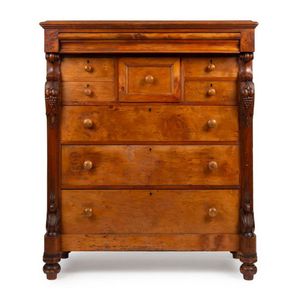19th Century Australian Huon Pine Chest of Drawers
You must be a subscriber, and be logged in to view price and dealer details.
Subscribe Now to view actual auction price for this item
When you subscribe, you have the option of setting the currency in which to display prices to $Au, $US, $NZ or Stg.
- Huon Pine - Named after the Frenchman who discovered the Huon River in Tasmania, it is an extremely slow growing and long living tree. Huon pine is native to Tasmania, and it can grow to an age of 3,000 years or more. The wood contains oil that retards the growth of fungi, hence its early popularity in ship-building in convict-era Tasmania. The timber is a warm yellow colour, finely grained, and was popular for household furniture in the Victorian era. Interestingly, much Huon pine furniture was made in South Australia. Huon pine is a protected species and only limited quantities are available nowadays, for craftsmen to manufacture small items such as platters, sculptures and other decorative objects.
- Kauri - An evergreen conifer tree associated with New Zealand, but also grown in northern Australia, and islands around the Pacific rim including Borneo, Vanuatu and New Guinea. The timber is generally golden in colour, and straight grained without much knotting.
A by-product of the kauri tree was the kauri gum, the fossilised resin extracted from the tree. The gum was obtained through digging, fossicking in treetops, or more drastically, by bleeding live trees. Kauri gum was used in the manufacture of varnishes and other resin-based products, and also crafted into jewellery, keepsakes, and small decorative items.
Kauri forests were prolific in the north of the North Island of New Zealand. European settlers in the 1700 and 1800s realised that the timber from these tall trees with broad trunks would be ideal for ship building and construction and a thriving industry was established harvesting the kauri tree. The forests were substantially reduced, and now the remaining Kauri trees that grow in New Zealand are protected, and there are reserves in various areas of the North Island.
The remaining stands of kauri in New Zealand are under threat from "kauri disease", a microscopic organism that causes dieback in the trees, with vast tracts either dead or dying. - Secondary Timbers - As indicated by the name, these are less expensive and thus lower quality timbers used in the construction of an item in surface areas that may not generally be seen, such as backboards, or as the ground for veneers, drawer linings or for framing.
This item has been included into following indexes:
- chests of drawers, material
- chests of drawers, period - Victorian 1,167
- chests of drawers, style - eight drawer 85
Visually similar items

Cantilever Colonial cedar chest of 5 drawers. A fine example with cockbeading to drawers, blackwood end grain handles, turned columns & huon pine secondary timbers. Tasmanian origin c1840. Height 120 cm, width 121 cm, depth 57 cm

An Australian cedar 8 drawer chest with turned columns, Circa 1880. 130 cm high, 125 cm wide, 54 cm deep.

A fine Australian cedar seven drawer chest, circa 1880, nine drawers flanked by two carved corbels, on turned feet, 149 x 121 x 58 cm. Provenance: Purchased from Marvin Hurnall antiques

A Georgian style oak small proportion chest on chest, raised on bracket feet, the base with three full width drawers, the top with four, curving detail to the pediment, brass drop handles with decorative back plates and keyhole escutcheons. 61 cm x 44 cm x
